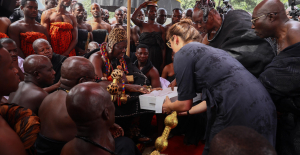If you want to keep an overview, you have to aim as high as possible. Since time immemorial, towers have served as observation points in order to be able to spy out real or potential enemies as best as possible. And not even eleven years after the first balloon flight with people on board in November 1783, the revolutionary army of the French Republic founded the "Compagnie d' aérosiers", the first department for airborne reconnaissance, in early 1794.
From this department there is a direct line to the Russian Beriev A-50 air patrol aircraft, which appears to have recently been badly damaged in Belarus. The technology has of course made tremendous progress, but the principle has remained the same. Today it is called AWACS, short for Airborne Warning And Control System.
In many wars of the 19th and the first half of the 20th century, observation balloons were used, almost always as captive balloons slightly behind their own lines. But these aircraft were easy targets for enemy artillerymen and from 1914 also for fighter pilots.
At the beginning of the Second World War, radar using electromagnetic pulses became available as a new reconnaissance technology. But initially the required systems were too large to be built into aircraft. The Royal Air Force set up a ground-based network of transmitters and receivers called "Chain Home" which could quite reliably detect approaches from the south, east and north and guide fighter planes to their targets. But throughout the west, this radar network had a huge gap.
Hence the idea of using airborne radar systems here. In the spring of 1942 there were first tests with a converted bomber of the outdated type Vickers Wellington, on the fuselage of which a radar antenna rotated. The machine was to detect approaches and later the German attack speedboats that could not be detected by "Chain Home", but could be detected from a great height. The idea didn't work out and the trials were interrupted. In 1944 there were renewed tests with airborne surveillance radar to find approaching German V-1s, the first (primitive) cruise missiles in the history of the war.
In 1944, independently of the British, the US Navy tested airborne radar systems for perimeter reconnaissance of carrier battle groups. With a converted torpedo bomber, potential enemy machines could be detected from a distance of 160 kilometers. The program, which did not produce operational machines until March 1945, was called "Cadillac".
A parallel development of the US Army Air Corps, forerunner of the US Air Force, was called "Cadillac II". Four-engine bombers of the Boeing B-17 type, which was also already outdated, were the basis here. The idea was that these aircraft should follow the attack formations consisting of modern B-29s against Japan at maximum altitude and alert them to approaching interceptors. But these B-17s were no longer used, as they were only available in significant numbers in 1946.
At the beginning of the Cold War, these machines strengthened the airspace surveillance of the North American continent, in addition to the constantly expanding ground-based radar system. Gaps in this reconnaissance network were then closed from 1952 to 1962 with blimps in service with the US Navy, whose radar antennas were installed inside the helium-filled envelopes. But what applied to the captive balloons of the 19th and early 20th centuries also applied to them: In the event of a conflict, these aircraft were easily attacked.
In the meantime, however, the US Air Force and the US Navy had become convinced of the need for airborne reconnaissance. And not just in the United States itself, but also during operations far from home. The main aim was to identify enemy air forces at an early stage and direct their own fighters to defend them. From then on, the flying eyes made a significant difference in air warfare.
In 1949 the Lockheed EC-121 Warning Star entered service. She carried large, long-range radars, one above and one below the fuselage. The crew consisted of 18 men, seven of whom were radar interpreters and technicians. Both the Air Force and the Navy used this type, but it was far too large to be launched from aircraft carriers.
Therefore, in 1957, the US Navy ordered one hundred Grumman E-1 Tracer twin-engine radar reconnaissance aircraft for the carrier fleet. From the start, this machine was designed as an interim solution. Since the much more powerful E-2 Hawkeye was already available from 1966, only 88 Tracers were built, which were retired by 1977. The E-2 Hawkeye, on the other hand, is still in service in the 21st century and is even standard equipment on the newest aircraft carrier, the USS "Gerald R. Ford".
Since 1965, several EC-121 Warning Stars were deployed in the Vietnam War, directing US fighters into action against enemy MiGs. The advantage: With the powerful flying radar, huge airspaces could be effectively monitored from a great distance; in addition, the US combat machines had to switch on their own radar just before interception, which made their detection by the enemy more difficult. According to official information, a North Vietnamese aircraft was shot down for the first time on October 24, 1967 thanks to the guidance of a Warning Star.
The EC-121, powered by double radial engines, were hopelessly outdated by the mid-1960s at the latest, even if their radar technology was constantly being modernized. Both manufacturers of suitable modern carrier aircraft, Boeing and McDonnell-Douglas, proposed their long-range four-engine passenger jets DC-8 and 707 as a basis. The Boeing was selected and adjusted; the first two prototypes had their maiden flight in 1972.
The construction of the radar was fundamentally new: It was no longer divided into two units under the fuselage and on top of it, but placed on a 3.35 meter high, aerodynamically shaped tripod between the wings and vertical stabilizer. The carrier aircraft practically no longer obstructs the radar signals.
This machine went into series production as the E-3A Sentry; A total of 68 aircraft were built by 1991, of which 32 are in service with the US Air Force in February 2023 and 16 with multinational crews at NATO. France operates four Boeing AWACS and Saudi Arabia five. Two older aircraft that have already been decommissioned by the British Royal Air Force are flying for Chile.
A total of three E-3As, two American and one NATO, were lost in flight accidents. As of 2023, the rest should be kept operational for at least five, maybe even ten years. In terms of radar technology, the machines of the US Air Force and NATO are up to date anyway.
You can also find "World History" on Facebook. We are happy about a like.

 New York: at Columbia University, the anti-Semitic drift of pro-Palestinian demonstrations
New York: at Columbia University, the anti-Semitic drift of pro-Palestinian demonstrations What is Akila, the mission in which the Charles de Gaulle is participating under NATO command?
What is Akila, the mission in which the Charles de Gaulle is participating under NATO command? Lawyer, banker, teacher: who are the 12 members of the jury in Donald Trump's trial?
Lawyer, banker, teacher: who are the 12 members of the jury in Donald Trump's trial? After 13 years of mission and seven successive leaders, the UN at an impasse in Libya
After 13 years of mission and seven successive leaders, the UN at an impasse in Libya What High Blood Pressure Does to Your Body (And Why It Should Be Treated)
What High Blood Pressure Does to Your Body (And Why It Should Be Treated) Vaccination in France has progressed in 2023, rejoices Public Health France
Vaccination in France has progressed in 2023, rejoices Public Health France Food additives suspected of promoting cardiovascular diseases
Food additives suspected of promoting cardiovascular diseases “Even morphine doesn’t work”: Léane, 17, victim of the adverse effects of an antibiotic
“Even morphine doesn’t work”: Léane, 17, victim of the adverse effects of an antibiotic Unemployment insurance: tightening of the rules on July 1
Unemployment insurance: tightening of the rules on July 1 Cancers, chronic diseases... Billions of workers hit by climate change, warns the UN
Cancers, chronic diseases... Billions of workers hit by climate change, warns the UN Closure of the A13 extended until at least mid-week
Closure of the A13 extended until at least mid-week Closure of the A13: Pécresse “asks the State to take charge of making the A14 free”
Closure of the A13: Pécresse “asks the State to take charge of making the A14 free” The series adaptation of One Hundred Years of Solitude promises to be faithful to the novel by Gabriel Garcia Marquez
The series adaptation of One Hundred Years of Solitude promises to be faithful to the novel by Gabriel Garcia Marquez Racism in France: comedian Ahmed Sylla apologizes for “having minimized this problem”
Racism in France: comedian Ahmed Sylla apologizes for “having minimized this problem” Mohammad Rasoulof and Michel Hazanavicius in competition at the Cannes Film Festival
Mohammad Rasoulof and Michel Hazanavicius in competition at the Cannes Film Festival UK lends Ghana treasures stolen during colonization
UK lends Ghana treasures stolen during colonization Skoda Kodiaq 2024: a 'beast' plug-in hybrid SUV
Skoda Kodiaq 2024: a 'beast' plug-in hybrid SUV Tesla launches a new Model Y with 600 km of autonomy at a "more accessible price"
Tesla launches a new Model Y with 600 km of autonomy at a "more accessible price" The 10 best-selling cars in March 2024 in Spain: sales fall due to Easter
The 10 best-selling cars in March 2024 in Spain: sales fall due to Easter A private jet company buys more than 100 flying cars
A private jet company buys more than 100 flying cars This is how housing prices have changed in Spain in the last decade
This is how housing prices have changed in Spain in the last decade The home mortgage firm drops 10% in January and interest soars to 3.46%
The home mortgage firm drops 10% in January and interest soars to 3.46% The jewel of the Rocío de Nagüeles urbanization: a dream villa in Marbella
The jewel of the Rocío de Nagüeles urbanization: a dream villa in Marbella Rental prices grow by 7.3% in February: where does it go up and where does it go down?
Rental prices grow by 7.3% in February: where does it go up and where does it go down? Europeans: “All those who claim that we don’t need Europe are liars”, criticizes Bayrou
Europeans: “All those who claim that we don’t need Europe are liars”, criticizes Bayrou With the promise of a “real burst of authority”, Gabriel Attal provokes the ire of the opposition
With the promise of a “real burst of authority”, Gabriel Attal provokes the ire of the opposition Europeans: the schedule of debates to follow between now and June 9
Europeans: the schedule of debates to follow between now and June 9 Europeans: “In France, there is a left and there is a right,” assures Bellamy
Europeans: “In France, there is a left and there is a right,” assures Bellamy These French cities that will boycott the World Cup in Qatar
These French cities that will boycott the World Cup in Qatar Basketball (F): big winner of Asvel, Basket Landes will face Tarbes in the semi-final of the League
Basketball (F): big winner of Asvel, Basket Landes will face Tarbes in the semi-final of the League Football: Yazici (Lille) “in shock” after an attempted theft at his home
Football: Yazici (Lille) “in shock” after an attempted theft at his home Serie A: victorious over AC Milan, Inter crowned Italian champions for the 20th time
Serie A: victorious over AC Milan, Inter crowned Italian champions for the 20th time Serie A: “Winning a title in a derby has never happened,” relishes Martinez after Inter’s coronation
Serie A: “Winning a title in a derby has never happened,” relishes Martinez after Inter’s coronation


















